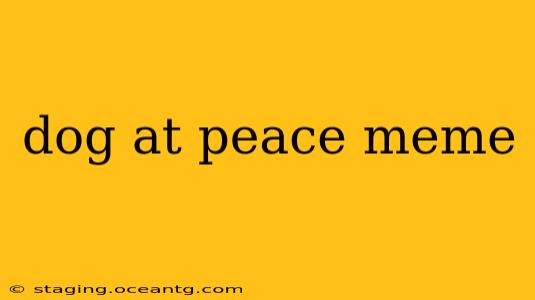The "dog at peace" meme is more than just a cute picture; it represents a powerful yearning for tranquility and a relatable connection to our furry companions. This meme typically features a dog, often lying down or lounging comfortably, exhibiting an expression of utter contentment and relaxation. But what makes this meme so resonant? And what can we learn from a dog's seemingly effortless peace? Let's delve deeper into this internet phenomenon.
What Makes the "Dog at Peace" Meme So Popular?
The popularity of the "dog at peace" meme stems from several factors. Firstly, it taps into our innate human desire for peace and serenity. In our often-stressful lives, seeing a dog so completely at ease can be incredibly calming and even aspirational. Secondly, the meme often features dogs in relatable scenarios – napping in a sunbeam, curled up on a cozy blanket, or simply enjoying a quiet moment. This relatability makes the meme universally appealing. Finally, dogs are inherently endearing creatures, and their peaceful expressions are simply irresistible.
What Does it Mean When a Dog Looks "At Peace"?
A dog appearing "at peace" isn't simply about their physical posture. It’s a combination of body language cues that signal a relaxed and content state. These cues might include:
- Loose, relaxed body posture: No stiffness, tense muscles, or tucked tail.
- Soft, relaxed eyes: No wide, staring eyes or narrowed pupils indicative of fear or anxiety.
- Slow, relaxed breathing: Panting should be minimal or absent.
- A comfortable position: Curled up, sprawled out, or simply lying down in a relaxed manner.
- Absence of defensive or aggressive behaviors: No growling, snapping, or excessive barking.
When a dog displays all or most of these signs, it suggests a state of contentment and security.
How Can I Help My Dog Achieve Inner Peace?
Many factors contribute to a dog’s overall well-being and sense of peace. Consider these elements:
- Meeting their basic needs: Providing adequate food, water, shelter, and veterinary care is fundamental.
- Providing mental stimulation: Engaging in regular play, training, and puzzle-solving activities can significantly reduce stress and boredom.
- Establishing a safe and predictable routine: Dogs thrive on routine; predictability minimizes anxiety.
- Minimizing stress triggers: Identify and minimize exposure to stressful situations such as loud noises, unfamiliar people or animals, or overly exciting environments.
- Providing a comfortable and safe space: Create a dedicated den or quiet area where your dog can retreat and relax undisturbed.
Is There a Difference Between a Dog Being Sleepy and a Dog Being at Peace?
While sleep and peace are often intertwined, they're not synonymous. A sleeping dog might be tired but not necessarily at peace. A dog at peace can be awake and alert, simply relaxed and content. The key differentiator is the body language described earlier. A truly peaceful dog will exhibit a relaxed posture and soft, unfocused gaze, even when awake.
Why Does the "Dog at Peace" Meme Resonate So Deeply With People?
The meme's power lies in its simplicity and universality. It transcends cultural and linguistic barriers, speaking to a shared human desire for tranquility and a deep connection with our animal companions. The meme serves as a reminder of the simple joys in life and the profound peace that can be found in the presence of a beloved pet. It’s a testament to the unique bond we share with our dogs and the profound effect they have on our well-being.
Conclusion: Embracing the Canine Calm
The "dog at peace" meme is more than just a fleeting internet trend; it's a reflection of our desire for serenity and a celebration of the simple joys found in companionship. By understanding what contributes to a dog's peaceful state, we can not only appreciate these heartwarming memes but also strive to create a more harmonious and peaceful life for our canine companions.
